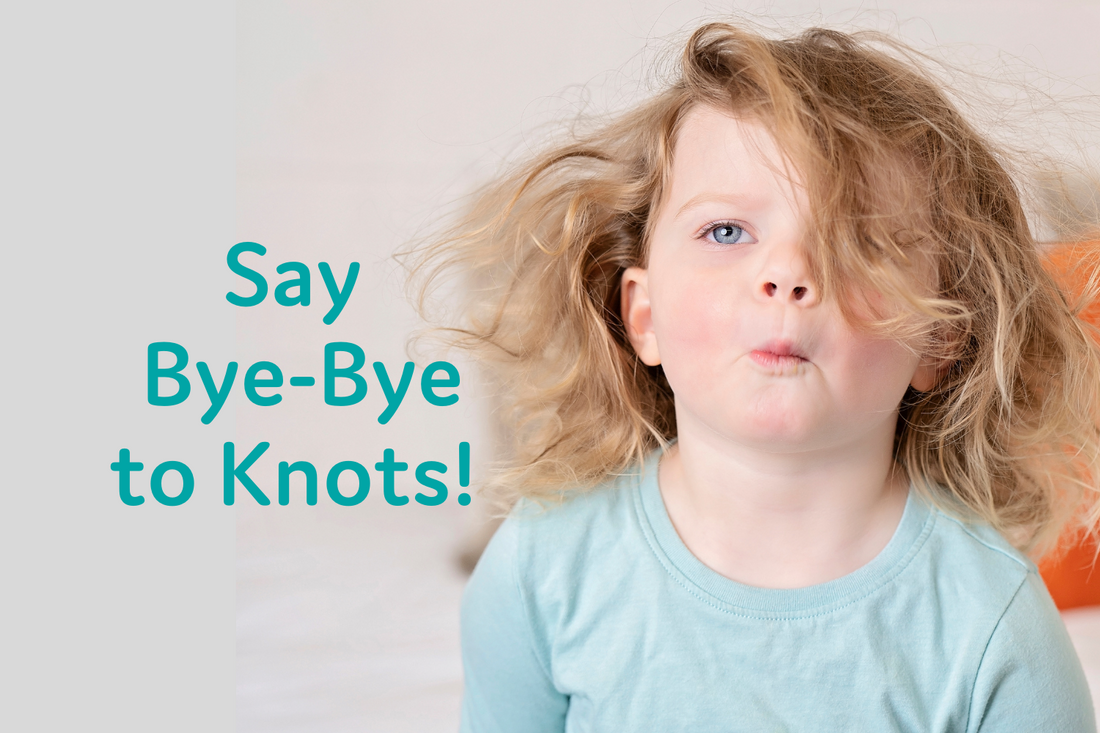Have you ever looked over at your kiddo and all you can see is knotted hair? Yikes!
 As your little one gets older, they become more active with friends, sports and swimming - and their hair can take a beating! It may become frizzy, knotted or develop tangles. To top it off, children often have more sensitive scalps than adults, making brushing even more of a challenge. Luckily there are some things you can do to minimize this problem. If you follow these steps, your little one will be tangle free in no time!
As your little one gets older, they become more active with friends, sports and swimming - and their hair can take a beating! It may become frizzy, knotted or develop tangles. To top it off, children often have more sensitive scalps than adults, making brushing even more of a challenge. Luckily there are some things you can do to minimize this problem. If you follow these steps, your little one will be tangle free in no time! 1. Detangling Shampoo & Conditioner
First off, let's talk shampoo. It's tempting to suds up every day, especially if your kiddo loves getting messy (don't they all?). But over-shampooing can strip their hair of its natural oils, leaving it dry and more prone to tangles. So, consider dialing it back a bit and shampooing every other day or even less frequently, depending on your child's hair type and activity level.
Now, onto the star of the show – conditioner. If you haven't already introduced it into your routine, now's the perfect time to start. A dab of natural conditioner during bath time can work wonders in preventing those pesky tangles.
But here's the secret sauce: don't rinse out all the conditioner. Leaving a bit in their hair helps keep it soft and manageable, making detangling a breeze. You can either pat their hair dry or try a leave-in conditioner for extra nourishment.
And speaking of detangling, have you heard about detangling shampoos? Give one a try and watch those knots disappear.
Pro tip: Only shampoo 2-3 a week and use JUST conditioner in between. It will help bond to the hair to make combing easier. If you child has sweaty hair and scalp, opt instead for a dry shampoo made specifically for kids.
2. Style Before Bedtime
If your child usually gets knots overnight, try putting it in a ponytail or braid to sleep which will minimize the tangles. We recommend a tighter braid, if possible, as it keeps the hair from moving as your child tosses and turns. If it is more stable, it is less likely to hang up on surrounding hairs. Stability of the hair naturally prevents tangles. Many stylists also recommend braiding, as it prevents tangles and creates wavy hair the next day. If you are good at braiding, some parents will tightly braid their child’s hair at night and let their wear the braid through the next day.

3. Time For a Haircut?
Not short, necessarily, but a trim to rid the hair of split ends will help minimize tangles. Since dry hair catches on other hairs and creates a knot, it is essential to keep the hair as healthy as possible. Split ends and damaged hair are far more likely to become knotted than shorter, healthier hair. If your child has extremely long hair (past mid-back), a quick trim to rid the dead ends may be beneficial. For some children, shorter hair also tangles, so this is not a cure-all, but it can help.

4. Tools Matter
We recommend using a wide-toothed comb, damp brush or a hairbrush specifically made for detangling. Start with the hair wet and brush or comb your child’s hair slowly and gently. If you are trying to work with hair that is already dry, you may want to add a natural product to wet it before attempting to detangle and remove the knots.
5. Brush Up!
Have you ever tried to brush and accidentally snagged a knot, leaving your little one in tears? We have a trick that can help! Brushing from the roots down can make tangles more challenging to remove. Gradually getting them out by ends up brushing can help remove even the nastiest knots. It is a good idea to use a leave-in conditioner or some water before you start, slowly brushing or combing nearest the ends and working your way up. You can do this in sections if the hair is thicker. Wet, conditioned hair with a wide-toothed comb or detangling brush is the best way to brush the hair, and if you do it from the bottom up, you will rid your little one of the worst knots more quickly.
6. Use Product to Detangle
Using hair detangling products is sometimes the best solution for your kid’s hair. T is for Tame has some of the best products on the market. Their line of taming products are specially formulated for children’s fine hair. They use “safe, clinically tested ingredients including coconut and jojoba oil,” according to their website. Coconut oil is often recommended as a natural detangler. This spray will help manage frizz and flyaways.

Final Thoughts
Whether you use T is for Tame alone or pair it with other methods, be sure that you are caring for your child’s hair with clean detangling tools and products. Healthy, smooth hair has less tendency to tangle and knot. Also, don't forget, your child’s scalp is far more sensitive than yours and you want to use products on their hair that are designed for kids.

